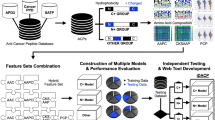Abstract
Here, cluster analysis showed that a database of 158 anticancer peptides formed 21 clusters based on net positive charge, hydrophobicity and amphiphilicity. In general, these clusters showed similar median toxicities (P = 0.176) against eukaryotic cell lines and no single combination of these properties was found optimal for efficacy. The database contained 14 peptides, which showed selectivity for tumour cell lines only (ACPCT), 123 peptides with general toxicity to eukaryotic cells (ACPGT) and 21 inactive peptides (ACPI). Hydrophobic arc size analysis showed that there was no significant difference across the datasets although peptides with wide hydrophobic arcs (>270°) appeared to be associated with decreased toxicity. Extended hydrophobic moment plot analysis predicted that over 50% of ACPCT and ACPGT peptides would be surface active, which led to the suggestion that amphiphilicity is a key driver of the membrane interactions for these peptides but probably plays a role in their efficacy rather than their selectivity. This analysis also predicted that only 14% of ACPCT peptides compared to 45% of ACPGT peptides were candidates for tilted peptide formation, which led to the suggestion that the absence of this structure may support cancer cell selectivity. However, these analyses predicted that ACPI peptides, which possess no anticancer activity, would also form surface active and tilted α-helices, clearly showing that other factors are involved in determining the efficacy and selectivity of ACPs.





Similar content being viewed by others
Abbreviations
- ACP:
-
Anticancer peptides
- ACPGT :
-
Anticancer peptides with general toxicity
- ACPCT :
-
Anticancer peptides with selectivity to tumour cell lines
- ACPI :
-
Inactive peptides
- 〈μH〉:
-
Mean hydrophobic moment
- 〈H〉:
-
Mean hydrophobicity
- H0 :
-
Null hypothesis
References
Hoskin DW, Ramamoorthy A (2008) Studies on anticancer activities of antimicrobial peptides. Biochim Biophys Acta 1778:357–375
Leuschner C, Hansel W (2004) Membrane disrupting lytic peptides for cancer treatments. Curr Pharm Des 10:2299–2310
Dennison SR, Whittaker M, Harris F, Phoenix DA (2006) Anticancer alpha-helical peptides and structure/function relationships underpinning their interactions with tumour cell membranes. Curr Protein Pept Sci 7:487–499
Papo N, Shai Y (2005) Host defense peptides as new weapons in cancer treatment. Cell Mol Life Sci 62:784–790
Dennison SR, Harris F, Phoenix DA (2005) Are oblique orientated alpha-helices used by antimicrobial peptides for membrane invasion? Protein Pept Lett 12:27–29
Dennison SR, Harris F, Phoenix DA (2007) The interactions of aurein 1.2 with cancer cell membranes. Biophys Chem 127:78–83
Marcotte I, Wegener KL, Lam YH, Chia BC, de Planque MR, Bowie JH, Auger M, Separovic F (2003) Interaction of antimicrobial peptides from Australian amphibians with lipid membranes. Chem Phys Lipids 122:107–120
Lins L, Brasseur R (2008) Tilted peptides: a structural motif involved in protein membrane insertion? J Pept Sci 14:416–422
Lins L, Decaffmeyer M, Thomas A, Brasseur R (2008) Relationships between the orientation and the structural properties of peptides and their membrane interactions. Biochim Biophys Acta 1778:1537–1544
Owen DR (2005) Short bioactive peptides in, Helix BioMedix. Inc., USA. United States Patent 6875744
Rost B, Sander C (1993) Prediction of protein secondary structure at better than 70% accuracy. J Mol Biol 232:584–599
Harris F, Wallace J, Phoenix DA (2000) Use of hydrophobic moment plot methodology to aid the identification of oblique orientated alpha-helices. Mol Membr Biol 17:201–207
Eisenberg D, Weiss RM, Terwilliger TC (1982) The helical hydrophobic moment: a measure of the amphiphilicity of a helix. Nature 299:371–374
Eisenberg D, Weiss RM, Terwillinger TC, Wilcox W (1982) Hydrophobic moment and protein structure. Farad Symp Chem Soc 17:109–120
Kaufman K, Rousseeuw PJ (1990) Finding groups in data: an introduction to cluster analysis. Wiley, Brisbane
Bechinger B, Zasloff M, Opella SJ (1993) Structure and orientation of the antibiotic peptide magainin in membranes by solid-state nuclear magnetic resonance spectroscopy. Protein Sci 2:2077–2084
Tossi A, Tarantino C, Romeo D (1997) Design of synthetic antimicrobial peptides based on sequence analogy and amphipathicity. Eur J Biochem 250:549–558
Acknowledgement
The authors would like to thank Dr Nadia Chuzhanova, University of Central Lancashire for her assistance with the cluster analysis.
Author information
Authors and Affiliations
Corresponding author
Rights and permissions
About this article
Cite this article
Dennison, S.R., Harris, F., Bhatt, T. et al. A theoretical analysis of secondary structural characteristics of anticancer peptides. Mol Cell Biochem 333, 129–135 (2010). https://doi.org/10.1007/s11010-009-0213-3
Received:
Accepted:
Published:
Issue Date:
DOI: https://doi.org/10.1007/s11010-009-0213-3




